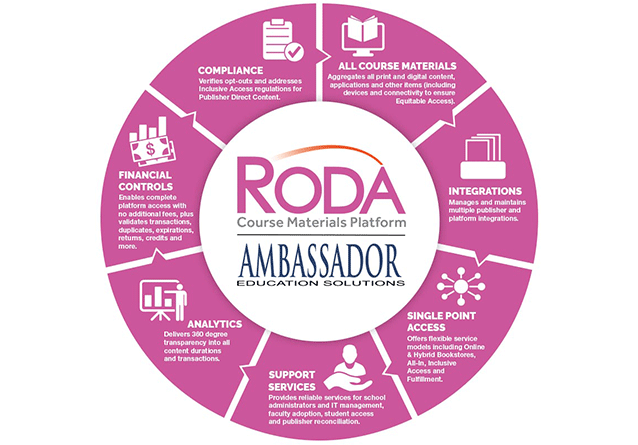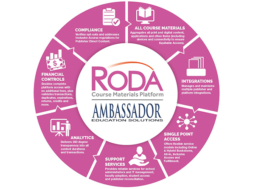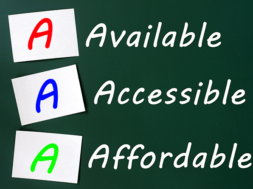
Course Materials are Changing: Are You Keeping Up?
Four Ways a Course Materials Platform Helps You Meet Today’s Challenges
By Laura Cavanaugh, Vice President of Sales, Ambassador Education Solutions
More course materials formats means more options for students to engage with course curriculum, which, by and large, sounds like a good thing. However, to those behind the scenes managing content adoption, access and affordability, the course materials process is anything but straightforward. The management of course materials is growing increasingly complicated. Schools are juggling a mix of print and digital resources, not to mention devices and connectivity; there are more platforms and rules to navigate; costs continue to be a source of student stress; and schools are ever mindful of overpaying for digital access.
A significant number of colleges are experiencing content fragmentation, especially as digital materials surge in popularity either as a complement to print textbooks or as stand-alone resources. Managing student choice and instructor preferences between print and digital adds another layer of complexity. Students are accessing different materials from different publishers and platforms, and schools’ IT teams and infrastructures oftentimes are left to shoulder the burden. What’s more, schools are adopting new and evolving content delivery models, which automate access for students but add additional workflows for the schools and publishers, not to mention the tremendous task of figuring out exactly what is owed for digital content.
Many schools today are looking to a Course Materials Platform to bridge the gap and streamline their operations and publisher relationships.
While on the surface managing digital content appears to be simple, these schools are realizing that’s not always the case. Specifically, a Course Materials Platform can be instrumental in helping schools overcome challenges with digital content access and management, integrations, financial controls and compliance.
1. Digital Content Capabilities
Digital media, including eTextbooks, is expected to grow at a compound annual growth rate of just under 4% by 2022.1 Even faculty are jumping on board. Faculty who prefer teaching with digital materials is reported to be approximately 25%, up from 10% two years ago.2
While digital content is gaining traction, implementing a digital program isn’t always as easy as it seems. There are a lot of moving parts. For starters, there is the management of the school’s digital catalogs, licenses and eReader accounts. This includes license code redemption, cancellation and reconciliation. Parameters also must be established for student access, including configuration based on non-expiring, semester-based and census-based durations. This becomes increasingly difficult when students use the same content across different courses and terms. Finally, schools need processes in place to avoid overpayments and handle duplicate purchases, returns and opt-outs in line with required deadlines and publisher policies. Opt-outs require publisher platforms to limit access as appropriate and schools to manage financial compensation/credit to students.
A Course Materials Platform can automate the entire digital content process, while providing print accommodations and other material formats required. It aligns terms, courses and enrollments with content information, availability, format, duration, editions, licenses, usage and transactions. Additionally, it can prevent students from purchasing the same item more than once unless the school chooses to override the functionality. It also provides schools greater visibility into the entire course materials lifecycle and greater control over those processes.
Additionally, as more schools offer device programs to their students to improve access to digital materials, a Course Materials Platform can help simplify the process. It can connect students with their recommended laptops, tablets and eReaders and ease the way schools manage device inventory, service and returns.
2. Seamless Integrations
All of this content management and maintenance can put a strain on a school’s IT resources. While integrations between the various systems and platforms are key to simplifying student access, content management, transaction verification, and even data analysis, it is often difficult for schools and publishers to manage the required integrations. A school’s systems need to be able to talk to each other. Additionally, a lot of schools have tried relying on their LMS to handle the requirements of digital content, but beyond content access, the LMS wasn’t necessarily built to facilitate the management aspects of a digital content program.
Having a Course Materials Platform in place simplifies the integration process. Because the Course Materials Platform integrates with a school’s operational, learning and financial systems, as well as publisher and partner platforms, everything comes together under one comprehensive system. A Course Materials Platform provides students with single point access to their course materials, which means they don’t have to navigate multiple platforms and they can focus more on the materials and less on the logistics.
For schools, a Course Materials Platform means they don’t have to dedicate their own internal IT resources to manage multiple integrations, plus they have ready access to the data and intelligence they need to measure usage and improve outcomes.
Specifically, digital course materials are full of relevant, actionable analytics. While it might be overwhelming for schools to collect all of the data on their own from each and every publisher and content platform, a Course Materials Platform can aggregate all of this information in one place, which can be extremely helpful when it comes to student intervention. For example, the Course Materials Platform can pull data so schools can identify specific usage and engagement trends, which helps them be more proactive when it comes to student support.
From the publisher perspective, they don’t have to integrate with each individual school, rather the Course Materials Platform serves as the source. Additionally, the Course Materials Platform can, depending on the integration functionality, lock down access to content where a student has opted-out, further protecting the publisher’s content. This is especially important for Publisher Direct Content, which can still be accessible to students via links through their LMS even if they have opted out.
3. Financial Controls
Believe it or not, overpayment for digital materials happens all of the time. Payments for digital course materials can be confusing, especially, for example, when you are dealing with an inventory of access codes – some of which are purchased, some of which are not, some of which have been billed against tuition even if a student opts-out, and some of which are accessible across more than one course or term. Keeping track of which students are using which materials and over which courses and terms requires substantial effort. Without strict data collection, storage and retrieval processes in place, schools don’t always know what they owe to the publishers, and because of the lack of transparency, they can end up overpaying.
A Course Materials Platform can provide verifiable transaction and usage data and ease reconciliation so schools and students only pay what they owe. Daily, weekly and monthly reconciliation reporting can assist in the required postings to student ledger accounts. Plus, publishers can verify fees owed to them. These financial controls reconcile exactly what materials students are using, and as a result, exactly what is owed. Another function of the Course Materials Platform can be to support de-duplication, which ensures that students and schools don’t overpay when using the same digital content (when the duration has not expired) for multiple courses and terms.
4. Regulatory Compliance
Schools must maintain Department of Education compliance with student opt-out policies when course materials are included in tuition and fees, for example in an Inclusive Access or Equitable Access program. From communicating opt-out actions to students in a clear and understandable way, to managing opt-out requests, calculating reimbursements and completing the opt-out process, schools need to make sure each and every step aligns with the federal requirements as well as publisher guidelines.
A Course Materials Platform can streamline the process in this regard.
It is important that a Course Materials Platform includes functionality to assist a school in satisfying opt-out regulations.
This includes providing a clear path for students to decline materials, validating opt-outs for varying durations and duplicates, and managing and processing financial credits.
It’s also important that the Course Materials Platform enable students to opt-out of some course materials without opting out of all of their course materials. Additionally, allowing students to opt back in to receive their materials at a later time can help improve student support and outcomes.
Keeping Up With the Times
As witnessed during the pandemic, many schools found themselves with a limited digital learning infrastructure to help transition to remote learning.3 Even as in-person learning returns in a fuller capacity this fall, we’ll continue to see students and faculty leverage digital materials. In fact, of all the course materials students said they purchased during the 2019-20 academic year, 21 percent were digital, which is a 7 percent increase from the previous year.4
Having a Course Materials Platform in place gives schools more flexibility to adapt to changing times and evolving student demands, but it also provides more robust support to students regardless if they use print or digital and if they learn on-campus or online. A Course Materials Platform can provide reliable, uninterrupted access to all print and digital course materials across all learning models, plus it eases the complex management processes and behind-the-scenes heavy lifting that schools and publishers have struggled to overcome.
Sources
- College Course Materials Trends and Outlook 2020-2022, Simba Information https://www.simbainformation.com/College-Course-Materials-Trends-Outlook-12781536/
- Faculty Watch: Attitudes & Behaviors Toward Course Materials, 2020, OnCampus Research, https://www.oncampusresearch.org/faculty-watch
- Remote Learning Technology Spending Market, Future Markets Insights, 2020, https://www.futuremarketinsights.com/reports/remote-learning-technology-spending-market
- Student Watch: Attitudes & Behaviors Toward Course Materials, 2021 https://www.oncampusresearch.org/student-watch
LAURA CAVANAUGH helps Ambassador’s clients strategize on content adoption, management, delivery and access using the company’s award-winning Course Materials Platform, RODA, which aggregates all print and digital materials, and layers it with integrations, single point access, support services, analytics, financial controls, and compliance. Laura has extensive experience in the EdTech and course materials industry, serving both K-12 and higher education. She kick-started her online bookstore tenure during the industry’s infancy and today specializes in strategy and implementation of all bookstore models, including online and hybrid bookstores, as well as Inclusive Access and all-in automatic fulfillment models. Laura’s education career also spans admissions and enrollment services and she has worked closely with large and small publishers to align their deliverables with schools’ and students’ needs.
Contact Information: Laura Cavanaugh // Vice President, Sales // Ambassador Education Solutions // 800-431-8913 // lcavanaugh@ambassadored.com // www.ambassadored.com // Twitter @ambassador_ed










